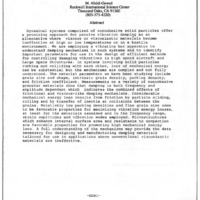-
Title
-
Passive Vibration Damping with Noncohesive Granular Materials
-
Report Number
-
WL-TR-91-3078 Volume III, p. GDB-1 thru GDB-14
-
Creator
-
Abdel-Gawad, M.
-
Corporate Author
-
Rockwell International Science Center
-
Date
-
1991
-
Date Issued
-
1991-08
-
Extent
-
14
-
Identifier
-
ADA241313
-
Format
-
1 online resource
-
Abstract
-
Dynamical systems comprised of noncohesive solid particles offer a promising approach for passive vibration damping as an alternative where viscous or viscoelastic materials become ineffective at high or low temperatures or in a hostile environment. We are employing a vibrating bar apparatus to understand damping mechanisms in such systems and to identify important parameters for use in the design of efficient methods for controlling damaging vibrations in high speed aircraft and Large Space Structures. In systems involving solid particles rubbing and colliding with each other, loss of mechanical energy can be substantial but the mechanisms are complex and not fully understood. The material parameters we have been studying include grain size and shape, intrinsic grain density, packing density, and friction coefficient. Measurements on a variety of noncohesive granular materials show that damping is both frequency and amplitude dependent which indicates the combined effects of frictional and viscous-like damping mechanisms. Considerable mechanical energy loss results from friction by particle sliding, rolling and by transfer of inertia at collisions between the grains. Relatively low packing densities and fine grain size seem to be favorable properties for maximizing vibration energy losses, at least for the materials e xamined and in the frequency range, strain amplitudes and vibration modes employed. Microstructures which enhance internal surface area and resistance to compaction are favorable properties for promoting high mechanical energy loss. A full understanding of the mechanisms may provide the data necessary for designing and manufacturing damping materials tailored for use in applications where conventional viscoelastic materials are ineffective.
-
Description
-
Dynamical systems comprised of noncohesive solid particles offer a promising approach for passive vibration damping as an alternative where viscous or viscoelastic materials become ineffective at high or low temperatures or in a hostile environment. We are employing a vibrating bar apparatus to understand damping mechanisms in such systems and to identify important parameters for use in the design of efficient methods for controlling damaging vibrations in high speed aircraft and Large Space Structures. In systems involving solid particles rubbing and colliding with each other, loss of mechanical energy can be substantial but the mechanisms are complex and not fully understood. The material parameters we have been studying include grain size and shape, intrinsic grain density, packing density, and friction coefficient. Measurements on a variety of noncohesive granular materials show that damping is both frequency and amplitude dependent which indicates the combined effects of frictional and viscous-like damping mechanisms. Considerable mechanical energy loss results from friction by particle sliding, rolling and by transfer of inertia at collisions between the grains. Relatively low packing densities and fine grain size seem to be favorable properties for maximizing vibration energy losses, at least for the materials e xamined and in the frequency range, strain amplitudes and vibration modes employed. Microstructures which enhance internal surface area and resistance to compaction are favorable properties for promoting high mechanical energy loss. A full understanding of the mechanisms may provide the data necessary for designing and manufacturing damping materials tailored for use in applications where conventional viscoelastic materials are ineffective.
-
Distribution Classification
-
1
-
Distribution Conflict
-
No
-
DTIC Record Exists
-
No
-
Illinois Tech Related
-
No
-
Photo Quality
-
Not Needed
-
Report Availability
-
Full text available
-
Type
-
article
 articleGDB
articleGDB